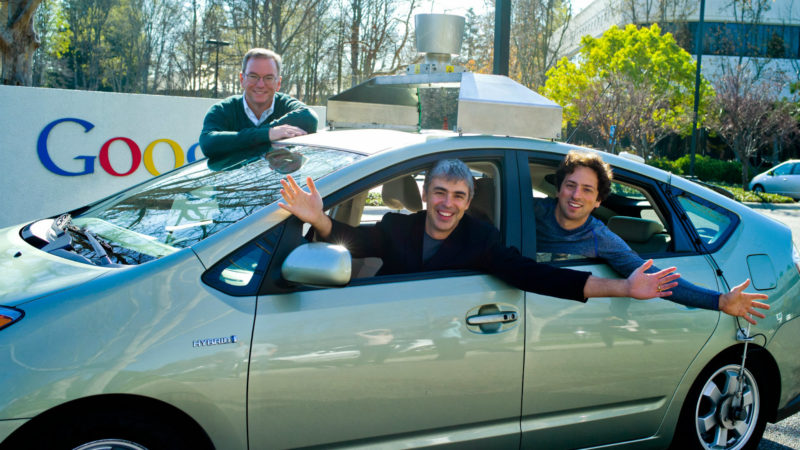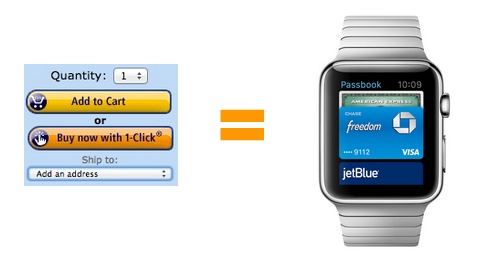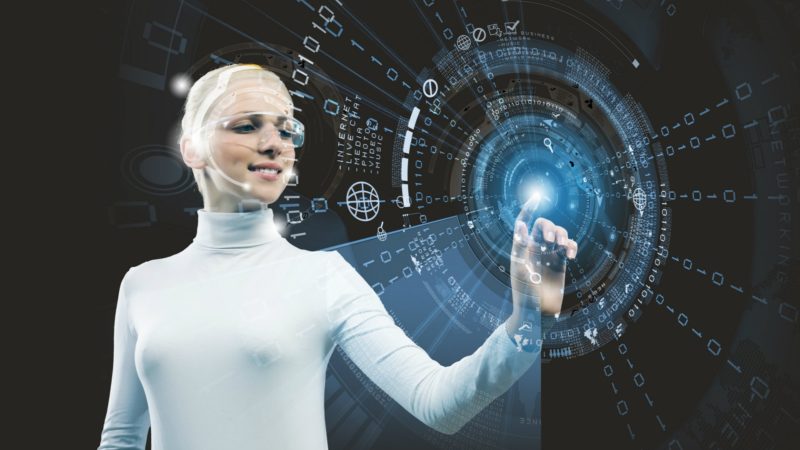These 3 New Technologies Should Keep Marketers Awake At Night
With so many exciting innovations on the horizon, which ones will marketers need to prepare for? Contributor Frederick Vallaeys looks at how technologies will change lives, and marketing.
Last week, I was in was Las Vegas to deliver a keynote at Impact14, the Internet Marketing Association’s annual conference event. I’d like to share some of my thoughts from that presentation here with you.
Unlike most of my talks, this one was not tactical; instead, it was meant to inspire and be thought provoking. That’s why I took a look at how new technologies from companies like Google, Apple, Amazon, and Uber may impact our professional lives as marketers.
While some of the technology that’s getting a lot of buzz may not immediately affect what we do, it’s only a matter of time before they mature — and impact the way that we, as marketers, have to think about the world in order to remain relevant.
Three of those technologies that I find particularly interesting are the self-driving car, drone-based delivery of physical goods, and wearable computing.
1. Self-Driving Cars
The self-driving car was the first project that put Google X on the map. When I first saw one of their early prototypes at the Google Ventures office, my initial reaction was that I wanted one of my own. After all, I like gadgets — and the self-driving car seems like the ultimate gadget.

Google’s First Iteration of Its Self-Driving Car. Image courtesy of Google.
At the time, I did not give much thought to what the self-driving car would mean for the world: in addition to making roads safer, it is poised to solve problems that have vexed society for a long time, like traffic congestion.
We’ve all seen enough new roads built in our lifetimes to know that building more capacity simply leads to more people using those roads, and traffic does not get better. Perhaps self-driving cars will be better drivers and make better use of the limited road capacity.
Even if they don’t solve the traffic problem, at least self-driving cars will free up our attention from the road ahead and give us back time, the most finite resource for any of us.
Personally, I much prefer spending six hours on a plane flying to New York than spending that same amount of time in a car driving to Lake Tahoe.
The difference is that flying is much more relaxing. I’m not saying I love the security lines or jostling with the other passengers to find a space for my bag — but once we get underway, it’s the pilot’s job to get us there safely, and I can catch up on some work, some reading or a movie.
With cars, on the other hand, the experience is more stressful since you’re the one whose job it is to get from A to B. Even if you’re not the driver, you have to help keep the driver alert; when you can see out the front window, you’re always a copilot — whether you want to be or not.
As marketers, the opportunity presented by the self-driving car is that we will get more time to connect with customers. The average American spends 38 hours each year stuck in traffic, and these are hours we could recoup to let people do what they want to do, and perhaps show them a few ads during the process.
Granted, this is a small portion of the time the average American spends watching TV or consuming other media, but short of figuring out how to make humans live longer (which Google is working on, too), doing more with the hours we have is one of the best ways to improve lives.

Imagine getting 38 hours of new opportunities to get your message in front of users on screens like the one seen here in this Tesla Model S. Image courtesy of Tesla.
When consumers get access to self-driving cars, they will also change their behaviors in terms of how they vacation.
For example, consider the roughly 3.8 million people that live in the Los Angeles area and are approximately 4 hours by car from Las Vegas. Many people that might enjoy spending a weekend in Vegas don’t make that trip because the drive is too long, the traffic is too uncertain or buying an airplane ticket at the last minute may be too expensive.
Imagine if those same people had access to a self-driving car, and they could leave from their house in LA and go door-to-door to any hotel in Las Vegas and do this on their own schedule. They could travel from LA to Vegas in the time it takes to watch a movie or two.
When people have access to more convenient transportation, they will be more likely to take these types of trips, and they will spend more time in the places where they want to be. The self-driving car will create new freedoms and give marketers a whole new market to pursue.
It’s even conceivable you’ll see people moving further from where they work, because when the commute is time being chauffeured around versus time spent in traffic, they can live where they want — either somewhere more affordable or somewhere more desirable.
I see this with Google’s commuter buses from San Francisco to Mountain View, which make it easy for a young Google employee to live where other singles live without dealing with two hours staring at the taillights of the car ahead every day.
That freedom, too, will lead to better lives with better quality time and more disposable income and more opportunities for marketers.
2. Instant Delivery
The second technology that I believe will have a big impact on marketers is instant delivery of physical goods.
Uber is a great example of how a more efficient delivery technology can have a big impact on the world: the average Uber driver earns three times as much as a taxi driver, and most Uber drivers would otherwise be unemployed.
The reason for Uber’s success is not just the fact that they make it easy for their customers to get a ride, but also that they have great technology to make sure their drivers are in the right place at the right time, where demand for rides will be greatest.
Uber deserves its sky high valuation of $18 billion not because it is a taxi company, but because it’s a data company that’s applying its technology to make transportation more efficient.
Last month, Uber blogged about how it can even predict where a user will want to go before they’re picked up. It also expanded its services, and now delivers packages in New York through UberRUSH. It’s making the delivery of stuff better in the same way it did for delivering people.
A more traditional entrant in the instant delivery game is Amazon. When it announced Amazon Prime Air on national television last year, I can only imagine that must have worried some folks over at Google. More people search for products on Amazon than they do on Google, according to Forrester.
And that makes perfect sense. After all, Amazon already has people’s payment information, and their 1-click buy button makes it easy for users to get what they want with a single click. Add to that a very reliable delivery system (Amazon often delivers packages that are supposed to arrive in two days overnight), and you have a great proposition for any shopper. Adding an even faster delivery option to that mix makes Amazon an even more formidable force in the ecommerce world.
Consequently, it makes sense that Google launched Google Shopping Express, a same-day delivery service that works with local stores. Based on my own experience, I find myself doing more searches for products on Google than I did before Express was introduced. Why wait for a package for two days when I can get it the same day from Google?
I also tried out Amazon Prime Fresh, which is Amazon’s version of same-day delivery. I know I may be biased toward Google, but the reason I like Express better than Fresh is that it delivers products I already know and trust.
I go shopping locally every week and have my favorite products at local stores. Often times, Amazon doesn’t have the same products, whereas Google Shopping Express does because it works directly with those merchants. Rather than having to try something new, I can stick with the tried and tested.
And, of course, Google is not standing still — it recently introduced Google Wing, which is a direct competitor to the Amazon Prime drone. The future of incredibly fast delivery of goods looks bright, especially now that the FAA is starting to figure out how to allow drones to operate in the American skies.

Google’s Answer to Delivery by Drone: Google Wing. Image From YouTube and Google.
What this all means for marketers is that consumers’ insatiable demand for instant gratification is only being fueled further.
When advertising on Google, offering free shipping is no longer enough to get the click (and it hasn’t been in some time). Consumers may now start to expect same-day delivery, and success will be measured in minutes rather than days.
When the drones are here, comparison shopping will increasingly be as much about delivery speed as it is now about price and features.
3. Wearables
The third technology is already here: wearables.
Technology like Google Glass has not seen widespread consumer adoption, in large part due to consumers’ unease with the technology in a social setting, where it is seen as a channel for violating other people’s privacy.
When it comes to our own privacy, we are all too happy to give it up — but when it is someone else making the decision for us, we are not okay with that.
But just because Google Glass may not find widespread consumer adoption does not mean it won’t be useful and widely adopted in business settings. Wearing a computer on your face while interacting with your friends in a social setting is akin to being glued to your phone at a dinner party — it’s rude.
But if a doctor needs quick access to information during surgery, or a firefighter entering a burning building needs the building’s blueprints, technology like Google Glass offers an awesome solution.
The wearable that is gaining more widespread adoption is the Smart Watch — and now that Apple has announced its own Apple Watch, momentum will only increase.
Smart Watches, unlike Google Glass, are much more stylish and provide a more subtle way of interacting with technology. A quick glance at the wrist to get the latest information is a lot more acceptable than wearing a screen on your face, because it’s hard to tell if the glass wearer is interacting with the computer or paying attention to the other person.
There are two aspects of Smart Watches that I find particularly appealing for marketers: instant notifications and frictionless commerce.
A. Easier Access To Notifications
Smart Watches are a great platform for sharing quick notifications and making those easily visible to users. I’m already a big fan and user of Google Now, the Android-based service that tries to answer my questions before I even knew to ask them by combining behavioral, location, and other data.
The biggest limitation of this service is that users have to pull out their phones and activate the screen to get to that useful information. With a Smart Watch, information is one step closer to the user’s attention.
Marketing is increasingly about personal conversations with individuals rather than with personas, so when we as marketers want to share a great piece of information with a user, we will be able to do so in a way that gets more easily noticed when the message can go to the Smart Watch.

“Google Now” Already Provides a Lot of Useful Information And Now It’s Available on People’s Wrists. Screenshots of The Google Now App on Android.
B. Smart Watch Wallets
When near-field communication (NFC) based payments arrive on Smart Watches, it will reduce friction in commerce in a similar way Amazon did it with their 1-click buy button.
While Android smartphones have already had the capability for NFC-based payments for several years, I believe that putting the payment device on the user’s wrist will make it much more accessible and drive hockey stick growth in adoption.

Wallets on Smart Phones Will Make Offline Commerce More Frictionless in The Same Way Amazon’s 1-Click Buy Button Did For ecommerce. Screenshot From Amazon.com and Image Courtesy of Apple.
Retailers may be able to install more points-of-sale and make transactions more seamless when users can make a payment with the tap of their wrist. I’ve seen a few retailers that already remove a lot of friction at the point-of-sale:
- At Home Depot, you can use a self-service checkout terminal and pay with PayPal
- At Nordstrom Rack, you can pay any associate without standing in the checkout line
- Best of all, at Apple stores, you can walk in, pick up your product, pay for it on your iPhone, and walk out of the store without ever talking to human
When you remove friction in a transaction, the number of transactions will increase. This is the promise of the Smart Watch with integrated wallets.
And this will create new opportunities for marketers, which will need to persuade users to take advantage of frictionless commerce when the traditional boundaries of stores will start to blur into the world around.
Marketers, Get Ready!
I’ve loved gadgets ever since I was a kid, and moving to the Silicon Valley when I was 15 was one of the greatest experiences of my life. I’m excited to see new technologies keep emerging from this great place and consider myself fortunate to be alive at a time when I can be a part of figuring out how to make use of it. I hope you’re as excited as I am about the future!
Opinions expressed in this article are those of the guest author and not necessarily MarTech. Staff authors are listed here.
Related stories
